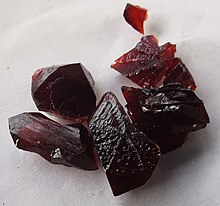(Benzylideneacetone)iron tricarbonyl is the organoiron compound with the formula (C6H5CH=CHC(O)CH3)Fe(CO)3. It is a reagent for transferring the Fe(CO)3 unit.[1] This red-colored compound is commonly abbreviated (bda)Fe(CO)3.
Structure and bonding
(bda)Fe(CO)3 is an example of a complex of an η2-ketone. It is a piano stool complex. The compound is characterized by IR bands at 2065, 2005, and 1985 cm−1 (cyclohexane solution), the three bands being indicative of the low symmetry of the complex, which is chiral.

It is prepared by the reaction of Fe2(CO)9 with benzylideneacetone.[2]
(bda)Fe(CO)3 sometimes reacts with Lewis bases to give adducts without displacement of the bda.[3] The reagents of the type (bda)Fe(CO)2(PR3) function as sources of "Fe(CO)2(PR3)" (R = aryl, etc.).[4]
Other sources of Fe(CO)3 are Fe2(CO)9 and Fe(CO)3(cyclooctene)2. The latter is highly reactive and thermally sensitive. Imine derivatives of cinnamaldehyde, e.g. C6H5CH=CHC(H)=NC6H5, also form reactive Fe(CO)3 adducts, which have been shown to be superior in some ways to (bda)Fe(CO)3.[5]
References
- ^ Knölker, Hans-Joachim (2001-04-15). "(η4-Benzylideneacetone)tricarbonyliron". In John Wiley & Sons, Ltd (ed.). (η 4 -Benzylideneacetone)tricarbonyliron. Chichester, UK: John Wiley & Sons, Ltd. doi:10.1002/047084289x.rb058. ISBN 978-0-471-93623-7.
- ^ Domingos, A. J. P.; Howell, J. A. S.; Johnson, B. F. G.; Lewis, J. (1990). "Reagents for the Synthesis of η-Diene Complexes of Tricarbonyliron and Tricarbonylruthenium". Inorg. Synth. Inorganic Syntheses. Vol. 28. pp. 52–55. doi:10.1002/9780470132593.ch11. ISBN 9780470132593.
- ^ A.S. Howell, James; Kola, John C.; Dixon, Denis T.; Burkinshaw, Philip M.; Thomas, Marion J. (1984). "The kinetics and mechanism of diene exchange in (η4-enone) Fe(CO)2L complexes (L = phosphine, phosphite)". Journal of Organometallic Chemistry. 266 (1): 83–96. doi:10.1016/0022-328X(84)80113-8.
- ^ Johnson, Brian F. G.; Lewis, Jack; Stephenson, G. Richard; Vichi, Eduardo J. S. (1978). "Preparation and reactions of triphenylphosphine and triphenyl phosphite complexes of (benzylideneacetone)dicarbonyliron(0)". Journal of the Chemical Society, Dalton Transactions (5): 369–373. doi:10.1039/dt9780000369. ISSN 0300-9246.
- ^ Knölker, Hans-Joachim; Braier, Arnold; Bröcher, Dirk J.; Cämmerer, Simon; Fröhner, Wolfgang; Gonser, Peter; Hermann, Holger; Herzberg, Daniela; Reddy, Kethiri R.; Rohde, Guy (2001-07-01). "Recent applications of tricarbonyliron-diene complexes to organic synthesis". Pure and Applied Chemistry. 73 (7): 1075–1086. doi:10.1351/pac200173071075. ISSN 1365-3075. S2CID 98692646.
Further reading
- Alcock, Nathaniel W.; Richards, Christopher J.; Thomas, Susan E. (1991). "Preparation of tricarbonyl(.eta.4-vinylketene)iron(0) complexes from tricarbonyl(.eta.4-vinyl ketone)iron(0) complexes and their subsequent conversion to tricarbonyl(.eta.4-vinylketenimine)iron(0) complexes". Organometallics. 10 (1): 231–238. doi:10.1021/om00047a054. ISSN 0276-7333.


Recent Comments